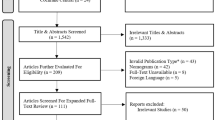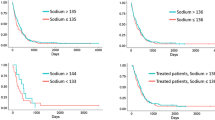Abstract
To determine whether serum albumin levels, before first surgery, predict time until death, 24 glioblastoma multiforme patients newly diagnosed at Ohio State University and Cleveland Clinic Foundation Hospitals between 1993 and 1995 were followed until 1996. Patients with presurgical serum albumin levels below 3.4 mg/dL survived an average (median) of 62 days (95% confidence interval (CI): 34, 135 days) after surgery. Those with serum albumin levels of at least 3.4 mg/dL survived an average of 494 days (95% CI: 241, 624 days). The association between serum albumin level and time until death persists when adjusted for demographic and treatment variables using Cox proportional hazards regression. Adjusted hazard ratios, by quartile of presurgical serum albumin level, are: 1.0, 1.2, 0.1, 0.1 (P-value for trend test=0.007). In addition to providing a prognostic indicator, presurgical serum albumin levels can be used to evaluate the success of randomization of clinical trials for glioblastoma multiforme therapies. Our findings are consistent with results seen for tumors at other sites. We speculate that our results may be attributable to an association between low serum albumin levels and physiological events associated with angiogenesis.
Similar content being viewed by others
References
Giles GG, Gonzales MF: Epidemiology of brain tumors and factors in prognosis. In: Kaye AH, Laws, ER Jr (eds) Brain Tumors: An Encyclopedic Approach. Churchill Livingstone: New York, 1995, pp 47–67
Salmon I, Dewitte O, Pasteels J-L, Flament-Durand J, Brotchi J, Vereerstraeten P, Kiss R: Prognostic scoring in adult astrocytic tumors using patient age, histopathological grade, and DNA histogram type. J Neurosurg 80: 877–883, 1994
Rainov NG, Dobberstein K-U, Bahn H, Holzhausen H-J, Lautenschlager C, Heidecke V, Burkert W: Prognostic factors in malignant glioma: influence of the overexpression of oncogene and tumor-suppressor gene products on survival. J Neurooncol 35: 13–28, 1997
McKeever PE, Ross DA, Strawderman MS, Brunberg JA, Greenberg HS, Junck L: A comparison of the predictive power for survival in gliomas provided by MIB-1, bromodeoxyuridine and proliferation cell nuclear antigen with histopathologic and clinical parameters. J Neuropathol Exp Neurol 56: 798–805, 1997
Salcman M: Glioblastoma and malignant astrocytoma. In: Kaye AH, Laws, ER Jr (eds) Brain Tumors: An Encyclopedic Approach. Churchill Livingstone: New York, 1995, pp 449–447
Falconer JS, Fearon KCH, Ross JA, Elton R, Wigmore SJ, Garden J, Carter DC: Acute-phase protein response and survival duration of patients with pancreatic cancer. Cancer 75: 2077–2082, 1994
Gough DB, Fearon KCH, Carter DC: Metabolic disturbance and sensitivity of endotoxin in patients with advanced cancer: relationship to lymphocyte reactivity, tumor necrosis factor (TNF) production and survival. Clin Exp Immunol 105: 529–539, 1996
Pasqualetti P, Collacciani A, Maccarone C, Casale R: Prognostic factors in multiple myeloma: selection using Cox's proportional hazard model. Biomed and Pharmacother 50: 29–25, 1996
Citterio G, Bertuzzi A, Tresoldi M., Galli, Di Lucca G, Scaglietti U, Rugarli C: Prognostic factors for survival in metastatic renal cell carcinoma: Retrospective analysis from 109 consecutive patients. Eur Urol 31: 286–291, 1997
Maltoni M, Pirovano M, Nanni O, Marinari M, Indelli M, Gramazio A, Terzoli E, Luzzani M, De Marinis F, Caraceni A, Labianca R, and Italian multicenter study group on palliative care. Biological indices predictive of survival in 519 Italian terminally ill cancer patients. J Pain Symptom Manage 13: 1–9, 1997
Maestu I, Pastor M, Gomez-Codina J, Aparicio J, Oltra A, Herranz C, Montalar J, Munarriz B, Reynes G: Pretreatment prognostic factors for survival in small-cell lung cancer: A new prognostic index and validation of three known prognostic indices on 341 patients. Ann Oncol 8: 547–553, 1997
Bastion Y, Sebban C, Berger F, Felan P, Salles G, Dumontet C, Bryon PA, Coiffer B: Incidence, predictive factors, and outcome of lymphoma transformation in follicular lymphoma patients. J Clin Oncol 15: 1587–1594, 1997
Mackiewicz A: Acute phase proteins and transformed cells. Int Rev Cytol 170: 225–296, 1997
Seymour JF, Talpaz M, Hagemeister FB, Cabanillas F, Kurzrock R: Clinical correlates of elevated serum levels of interleukin 6 in patients with untreated Hodgkin's Disease. Am J Med 102: 21–28, 1997
Thiounn N, Pages F, Flam T, Tartour E, Mosseri V, Zerbib M, Beuzeboc P, Deneux L, Fridman WH, Debre B: IL-6 is a survival prognostic factor in renal cell carcinoma. Immunol Lett 58: 121–4, 1997
Neugut AI, Fink DJ, Radin D: Serum cholesterol and primary brain tumors: A case-control study. Int J Epidemiol 18: 798–801, 1989
Wolff JEA, Molenkamp G, Hotfilder M, Laterra J: Dexamethasone inhibits glioma-induced formation of capillary like structures in vitro and angiogenesis in vivo. Klin Padiatr 209: 275–277, 1997
Freshney RI: Effects of glucocorticoids on gliomas cells in culture; Minireview on cancer research. Expl Cell Biol 52: 286–289, 1984
Weissman DE, Dufer D, Vogel V, Abeloff MD: Corticosteroid toxicity in neuro-oncology patients. J Neurooncol 5: 125–128, 1987
Tontsch U, Bauer HC: Glial cells and neurons induce blood– brain barrier related enzymes in cultured cerebral endothelial cells. Brain Res 539: 247–253, 1991
Sattar N, Scott HR, McMillan DC, Talwar D, O'Reilly SJ, Fell GS: Acute-phase reactants and plasma trace element concentrations in non-small cell lung cancer patients and controls. Nutr Cancer 28: 308–312, 1997
Rothman KJ, Greenland S: Modern Epidemiology. Lippincott-Raven, Philadelphia, 1998
Shapiro WR, Shapiro JR: Biology and treatment of malignant glioma. Oncology 12: 233–240, 1998
Giometto B, Bozza F, Faresin F, Alessio L, Mingrino S, Tavolato B: Immune infiltrates and cytokines in gliomas. Acta Neurochirurgica 138: 50–56, 1996
Cohen T, Nahari D, Cerem LW, Neufeld G, Levi BZ: Interleukin 6 induces expression of vascular endothelial growth factor. J Biol Chem 271: 736–41, 1996
Merzak A, Pilkington GJ: Molecular and cellular pathology of intrinsic brain tumors. Canc Met Rev 16: 155–177, 1997
Abdulrauf SI, Edvardsen K, Ho Kl, Yang XY, Rock JP, Rosenbium ML: Vascular endothelial growth factor expression and vascular density as prognostic markers of survival of patients with low-grade astrocytoma. J Neurosurg 88: 513–20, 1998
Tjuvajev J, Uehara H, Desai R, Beattie B, Matei C, Zhou Y, Kreek M-J, Koutcher J, Blasberg R: Corticotropin-releasing factor decreases vasogenic brain edema. Cancer Res 56: 1352–1360, 1996
Hocks GM, Barry D, Fey GR: Synergistic action of interleukin-6 and glucocorticoids is mediated by the interleukin-6 response element of the rat alpha 2 macroglobulin gene. Mol Cell Biol 12: 2282–2294, 1992
Author information
Authors and Affiliations
Rights and permissions
About this article
Cite this article
Schwartzbaum, J.A., Lal, P., Evanoff, W. et al. Presurgical Serum Albumin Levels Predict Survival Time from Glioblastoma Multiforme. J Neurooncol 43, 35–41 (1999). https://doi.org/10.1023/A:1006269413998
Issue Date:
DOI: https://doi.org/10.1023/A:1006269413998




